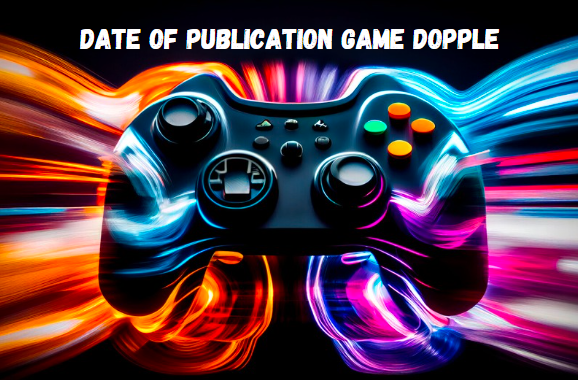The Comprehensive Guide to “Date of Publication Game Dopple”
Introduction
In the world of gaming, where new titles are constantly being released, understanding key aspects like the “date of publication” can significantly impact a game’s success and player engagement. For many, the term “date of publication game Dopple” might seem obscure, but it holds significant importance for gamers, developers, and publishers alike.
This article delves deep into the concept, providing a comprehensive and informative overview that goes beyond the surface to offer unique insights into what the “date of publication game Dopple” entails and its impact on the gaming industry.
Understanding the “Date of Publication” in Gaming
What Does “Date of Publication” Mean?
The “date of publication” in gaming refers to the official release date when a game becomes available to the public. This date is crucial as it marks the point when the game is accessible for purchase, download, or play across various platforms.
The significance of the publication date extends beyond just availability; it influences marketing strategies, sales performance, player reception, and even the critical reviews that follow.
Importance of the “Date of Publication” for Developers and Publishers
For game developers and publishers, selecting the right date of publication is a strategic decision. It involves considering multiple factors, including competition, market trends, and target audience behavior. A well-timed release can lead to high sales figures and strong community support, while a poorly chosen date can result in the game being overshadowed by other titles or missing key market opportunities.
The Concept of “Game Dopple”
What is a “Game Dopple”?
The term “Dopple” might be unfamiliar to many, but within certain gaming communities, it refers to a game that closely mirrors another in terms of theme, mechanics, or overall design. A “game Dopple” is essentially a doppelganger of another game, often created intentionally to capitalize on the success or popularity of the original.
Why Do “Game Dopples” Exist?
“Game Dopples” exist for various reasons. Sometimes, they are created to offer an alternative version of a popular game, perhaps with different features, storylines, or improved graphics. Other times, they are developed as part of a trend, where multiple developers jump on the bandwagon of a successful game genre or concept. In some cases, “game Dopples” might be unintentional, resulting from similar ideas being developed independently by different teams.
The Role of “Date of Publication” in the Success of “Game Dopples”
The date of publication is particularly critical for “game Dopples.” These games often compete directly with the original or other similar titles, so timing their release is essential. A well-timed release can allow a “game Dopple” to capture the interest of gamers who are seeking something new but familiar, while a poorly timed release might cause the game to be dismissed as a mere clone or knock-off.
Case Studies: Notable Examples of “Date of Publication Game Dopples”
Case Study 1: “Fortnite” and “PlayerUnknown’s Battlegrounds (PUBG)”
One of the most famous examples of a “game Dopple” scenario is the relationship between “Fortnite” and “PlayerUnknown’s Battlegrounds” (PUBG). PUBG popularized the battle royale genre, and “Fortnite” quickly followed, offering a similar experience but with unique elements like building mechanics and a more colorful, cartoonish aesthetic.
- Date of Publication Analysis: PUBG was released in March 2017, and “Fortnite: Battle Royale” launched in September 2017. The proximity of these dates allowed “Fortnite” to capitalize on the growing popularity of the battle royale genre while distinguishing itself with different gameplay mechanics.
- Impact on the Gaming Industry: “Fortnite” ultimately surpassed PUBG in popularity, partly due to its free-to-play model and continuous updates. The timing of its release was crucial in positioning it as a strong competitor, demonstrating how the “date of publication game Dopple” can influence the trajectory of a game’s success.
Case Study 2: “Apex Legends” and “Fortnite”
Another interesting case is “Apex Legends,” a battle royale game developed by Respawn Entertainment, which entered a market already dominated by “Fortnite.”
- Date of Publication Analysis: “Apex Legends” was released in February 2019, long after “Fortnite” had established its dominance. However, its surprise launch and innovative gameplay features, like character abilities and a ping communication system, allowed it to carve out its niche within the genre.
- Impact on the Gaming Industry: Despite launching later, “Apex Legends” quickly gained a large player base, proving that even in a saturated market, a “game Dopple” can succeed if it brings something new to the table and times its release effectively.
The Strategic Importance of “Date of Publication” in the Gaming Industry
Market Trends and Timing
Timing the release of a game, particularly a “game Dopple,” involves careful analysis of market trends. Developers and publishers must consider several factors, including:
- Seasonal Trends: Many games are released during the holiday season to capitalize on increased consumer spending. However, this period is also highly competitive, making it crucial for “game Dopples” to stand out with unique features or marketing strategies.
- Platform Availability: The release of new gaming consoles or platforms can significantly impact the success of a game. For instance, launching a “game Dopple” alongside a new console can boost its visibility and appeal to early adopters.
- Competitor Releases: Understanding the release schedules of competitors is vital. Releasing a game too close to a highly anticipated title can result in poor sales, as gamers may prioritize the more established or hyped game.
Marketing and Hype Generation
The “date of publication” also plays a critical role in marketing and hype generation. A well-timed marketing campaign can build anticipation and excitement leading up to the game’s release. This is especially important for “game Dopples,” which may need to overcome initial skepticism from players who see them as imitations.
- Pre-Release Marketing: This includes trailers, gameplay demos, and beta tests, which can generate interest and allow the game to build a community before its official release.
- Post-Release Support: Ongoing updates, events, and community engagement are essential for maintaining a game’s momentum, particularly for “game Dopples” that need to keep players engaged after the initial launch.
Challenges and Risks Associated with “Date of Publication Game Dopples”
Risk of Being Overshadowed
One of the primary risks for “game Dopples” is being overshadowed by the original game or other competitors. This can happen if the release date is too close to that of a more established or highly anticipated title. In such cases, the “game Dopple” may struggle to attract attention or be dismissed as a clone without offering anything new or innovative.
Balancing Innovation and Familiarity
While “game Dopples” often borrow heavily from the original game, they also need to innovate to stand out. Striking the right balance between familiarity and new features is crucial. A “game Dopple” that is too similar to the original may be seen as redundant, while one that deviates too much may fail to attract fans of the original game.
The Impact of Delays
Delays in the “date of publication” can be particularly damaging for “game Dopples.” Unlike original games, which may have a loyal fanbase willing to wait, “game Dopples” need to seize the moment when interest in the genre or concept is high. Delays can lead to lost momentum, increased competition, and a diminished impact upon release.
How to Optimize the “Date of Publication Game Dopple” Strategy
Conducting Market Research
Thorough market research is essential for determining the best release date for a “game Dopple.” This includes analyzing the competitive landscape, understanding player preferences, and identifying gaps in the market where the game can thrive.
- Player Demographics: Understanding the target audience is crucial. For example, a game aimed at a younger demographic may benefit from a summer release when school is out, while a game targeting older players might perform better during the holiday season when discretionary spending is higher.
- Genre Trends: Keeping an eye on emerging trends within the gaming industry can help identify opportunities for “game Dopples” to enter the market. For instance, if a particular genre is gaining popularity, releasing a “game Dopple” within that genre can be a successful strategy.
Leveraging Early Access and Beta Testing
Early access and beta testing can be effective tools for building a player base before the official release. These programs allow developers to gather feedback, make improvements, and generate buzz, all of which can contribute to a successful launch.
- Building a Community: Engaging with players during the early access phase helps build a loyal community that can act as ambassadors for the game once it is officially released.
- Improving the Final Product: Feedback from early access and beta testing can lead to valuable improvements, increasing the chances of a positive reception upon release.
Timing the Marketing Push
A well-timed marketing campaign can make all the difference for a “game Dopple.” The marketing push should begin several months before the release date, building momentum and keeping the game in the public eye.
- Utilizing Influencers and Streamers: Partnering with popular influencers and streamers can help generate interest and credibility for the “game Dopple,” especially among younger audiences who are heavily influenced by online personalities.
- Cross-Promotion: Leveraging partnerships with other games or platforms can increase visibility. For example, offering exclusive content or bonuses for players who pre-order or play the game within a certain timeframe can drive early adoption.
The Future of “Date of Publication Game Dopples”
Evolving Trends in Game Development
As the gaming industry continues to evolve, so too will the strategies surrounding “date of publication game Dopples.” The rise of digital distribution, global release strategies, and the increasing importance of live service models will all influence how and when these games are released.
- Global Release Strategies: With the increasing globalization of the gaming industry, developers must consider the timing of releases across different regions. A staggered release might benefit some “game Dopples,” allowing them to build momentum in one market before expanding to others.
- Live Service Models: Games as a Service (GaaS) models are becoming more prevalent, where the release date is just the beginning of a game’s lifecycle. “Game Dopples” that adopt this model can extend their relevance by continuously updating and evolving based on player feedback.
The Impact of Emerging Technologies
Emerging technologies, such as virtual reality (VR), augmented reality (AR), and cloud gaming, are likely to create new opportunities and challenges for “game Dopples.” As these technologies become more mainstream, the strategies for timing releases will need to adapt.
- VR and AR: As VR and AR gaming grow, “game Dopples” in these spaces will need to carefully consider the timing of their release, especially if they aim to capitalize on the novelty and excitement surrounding these technologies.
- Cloud Gaming: Cloud gaming platforms like Google Stadia and Xbox Cloud Gaming are changing how games are distributed and played. “Game Dopples” that leverage cloud gaming can reach a broader audience without the constraints of traditional hardware, making the timing of their release even more critical.
FAQs
What is the significance of the “date of publication game Dopple”?
The “date of publication game Dopple” is crucial as it determines the game’s release timing, which can significantly impact its success, particularly in competitive genres. A well-timed release can capture player interest, while a poorly timed release can lead to the game being overshadowed by other titles.
How do developers decide the “date of publication” for a game Dopple?
Developers consider various factors, including market trends, competitor releases, and player demographics, when deciding the release date. They also conduct thorough market research and may use early access or beta testing to gauge player interest before finalizing the date.
Can a “game Dopple” be more successful than the original game?
Yes, a “game Dopple” can surpass the original game in success if it introduces innovative features, has a well-timed release, and executes a strong marketing campaign. The success of “Fortnite” compared to “PUBG” is a prime example.
What are the risks of delaying the “date of publication” for a game Dopple?
Delays can lead to lost momentum, increased competition, and a reduced impact upon release. For a “game Dopple,” this can be particularly damaging as it may miss the window of opportunity when player interest in the genre or concept is at its peak.
How does the rise of live service models affect the “date of publication” strategy?
Live service models extend a game’s relevance beyond its initial release date, making ongoing updates and player engagement crucial. For “game Dopples,” adopting this model can help maintain player interest and adapt to feedback, potentially leading to long-term success.
Conclusion
The “date of publication game Dopple” is a multifaceted concept that plays a critical role in the gaming industry. From influencing the success of “game Dopples” to shaping marketing strategies and player engagement, the timing of a game’s release is a strategic decision that requires careful consideration and planning.
As the gaming landscape continues to evolve, understanding and optimizing the “date of publication” will remain essential for developers and publishers seeking to make their mark in a competitive market. By leveraging market trends, conducting thorough research, and executing well-timed marketing campaigns, developers can ensure that their “game Dopples” not only succeed but also stand out in an increasingly crowded field.






